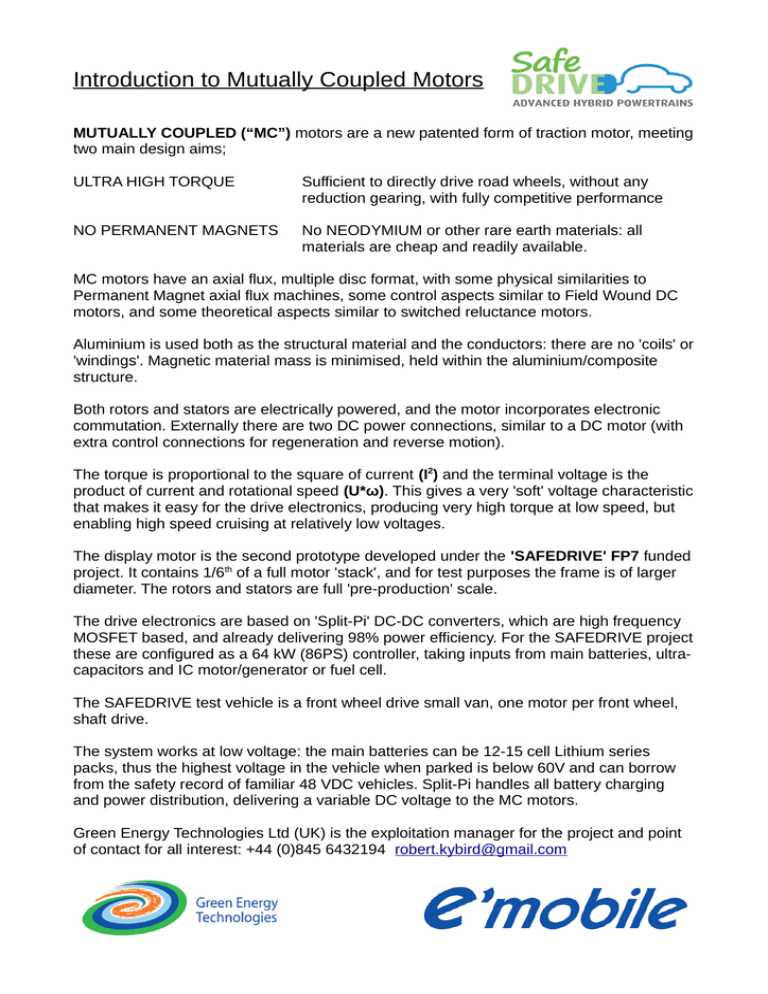Introduction to Mutually Coupled Motors
advertisement

Introduction to Mutually Coupled Motors MUTUALLY COUPLED (“MC”) motors are a new patented form of traction motor, meeting two main design aims; ULTRA HIGH TORQUE Sufficient to directly drive road wheels, without any reduction gearing, with fully competitive performance NO PERMANENT MAGNETS No NEODYMIUM or other rare earth materials: all materials are cheap and readily available. MC motors have an axial flux, multiple disc format, with some physical similarities to Permanent Magnet axial flux machines, some control aspects similar to Field Wound DC motors, and some theoretical aspects similar to switched reluctance motors. Aluminium is used both as the structural material and the conductors: there are no 'coils' or 'windings'. Magnetic material mass is minimised, held within the aluminium/composite structure. Both rotors and stators are electrically powered, and the motor incorporates electronic commutation. Externally there are two DC power connections, similar to a DC motor (with extra control connections for regeneration and reverse motion). The torque is proportional to the square of current (I2) and the terminal voltage is the product of current and rotational speed (U*ω). This gives a very 'soft' voltage characteristic that makes it easy for the drive electronics, producing very high torque at low speed, but enabling high speed cruising at relatively low voltages. The display motor is the second prototype developed under the 'SAFEDRIVE' FP7 funded project. It contains 1/6th of a full motor 'stack', and for test purposes the frame is of larger diameter. The rotors and stators are full 'pre-production' scale. The drive electronics are based on 'Split-Pi' DC-DC converters, which are high frequency MOSFET based, and already delivering 98% power efficiency. For the SAFEDRIVE project these are configured as a 64 kW (86PS) controller, taking inputs from main batteries, ultracapacitors and IC motor/generator or fuel cell. The SAFEDRIVE test vehicle is a front wheel drive small van, one motor per front wheel, shaft drive. The system works at low voltage: the main batteries can be 12-15 cell Lithium series packs, thus the highest voltage in the vehicle when parked is below 60V and can borrow from the safety record of familiar 48 VDC vehicles. Split-Pi handles all battery charging and power distribution, delivering a variable DC voltage to the MC motors. Green Energy Technologies Ltd (UK) is the exploitation manager for the project and point of contact for all interest: +44 (0)845 6432194 robert.kybird@gmail.com Introduction to Mutually Coupled Motors Target specification of MC1200 motor The display motor shown contains 1/6 th of the active material of the full motor being developed under the FP7 SAFEDRIVE project. The full motor is derived by 'stacking' five more sets of active material in an axial direction. The final housing will be smaller in diameter. The specification below is for the FULL MOTOR. It is of course subject to normal developmental change, but so far all parameters set theoretically are being fully met. TORQUE 1200 Nm Continuous rating liquid cooled version 10 second rating air cooled version Essentially flat torque to maximum speed if electrical power is available, controller dependant in practical use VOLTAGE 120 VDC CURRENT 320 A 1500 RPM Design figure for maximum road speed, not technology limit 38 kg Mass of conductors and magnetic material < 65 kg Including casing, shafts, bearings, commutation and rotary power transfer electronics ROTATIONAL SPEED MASS ACTIVE MATERIALS TARGET MASS TOTAL MOTOR DIAMETER AXIAL LENGTH ROTOR POWER COUPLING 385 mm <200 mm At 145 kph At 1200 Nm, low speed configuration Excluding shaft and mounting Inductive coupler



